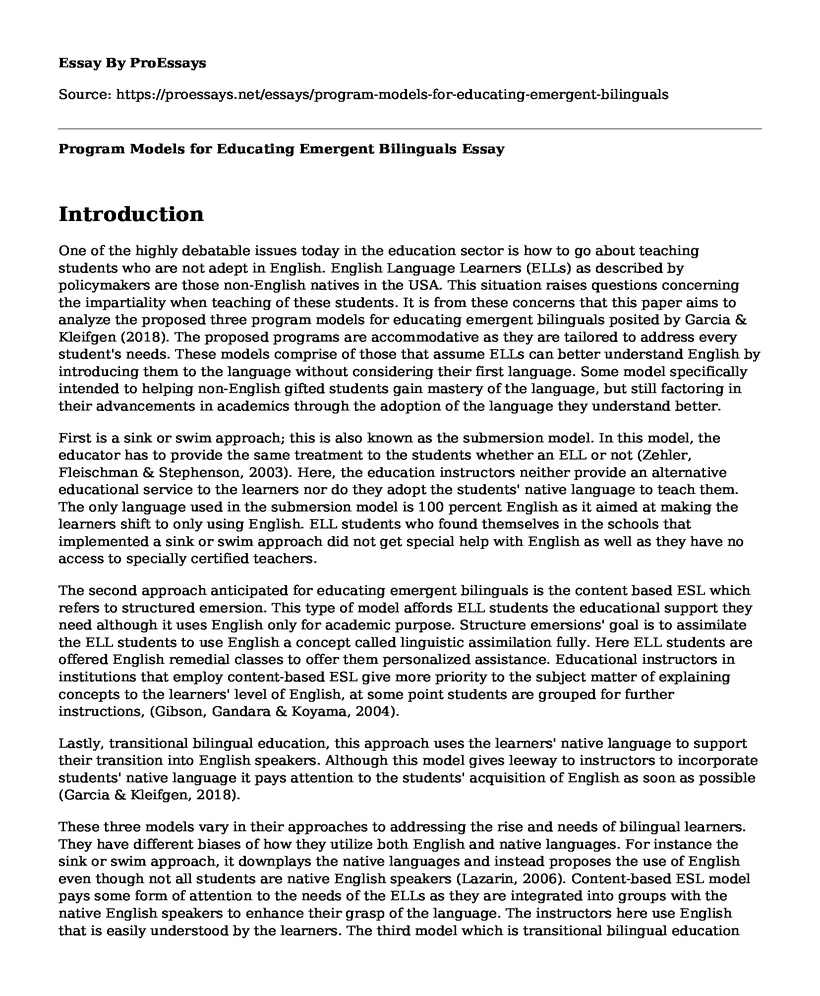Introduction
One of the highly debatable issues today in the education sector is how to go about teaching students who are not adept in English. English Language Learners (ELLs) as described by policymakers are those non-English natives in the USA. This situation raises questions concerning the impartiality when teaching of these students. It is from these concerns that this paper aims to analyze the proposed three program models for educating emergent bilinguals posited by Garcia & Kleifgen (2018). The proposed programs are accommodative as they are tailored to address every student's needs. These models comprise of those that assume ELLs can better understand English by introducing them to the language without considering their first language. Some model specifically intended to helping non-English gifted students gain mastery of the language, but still factoring in their advancements in academics through the adoption of the language they understand better.
First is a sink or swim approach; this is also known as the submersion model. In this model, the educator has to provide the same treatment to the students whether an ELL or not (Zehler, Fleischman & Stephenson, 2003). Here, the education instructors neither provide an alternative educational service to the learners nor do they adopt the students' native language to teach them. The only language used in the submersion model is 100 percent English as it aimed at making the learners shift to only using English. ELL students who found themselves in the schools that implemented a sink or swim approach did not get special help with English as well as they have no access to specially certified teachers.
The second approach anticipated for educating emergent bilinguals is the content based ESL which refers to structured emersion. This type of model affords ELL students the educational support they need although it uses English only for academic purpose. Structure emersions' goal is to assimilate the ELL students to use English a concept called linguistic assimilation fully. Here ELL students are offered English remedial classes to offer them personalized assistance. Educational instructors in institutions that employ content-based ESL give more priority to the subject matter of explaining concepts to the learners' level of English, at some point students are grouped for further instructions, (Gibson, Gandara & Koyama, 2004).
Lastly, transitional bilingual education, this approach uses the learners' native language to support their transition into English speakers. Although this model gives leeway to instructors to incorporate students' native language it pays attention to the students' acquisition of English as soon as possible (Garcia & Kleifgen, 2018).
These three models vary in their approaches to addressing the rise and needs of bilingual learners. They have different biases of how they utilize both English and native languages. For instance the sink or swim approach, it downplays the native languages and instead proposes the use of English even though not all students are native English speakers (Lazarin, 2006). Content-based ESL model pays some form of attention to the needs of the ELLs as they are integrated into groups with the native English speakers to enhance their grasp of the language. The instructors here use English that is easily understood by the learners. The third model which is transitional bilingual education seeks to hasten the winning process of Ells to speaking English although it employs the students' native language to some extent.
Conclusion
Despite all the attempts to make the education system more accommodating, there has been difficulty in fully exploiting these models. First, because most of the ELLs are capable of oral communication the capability of communicating orally using English, but they are facing challenges using English for academic purposes. Secondly, because the numbers of ELLs who are proficient in their native language vary across different schools and lastly the mechanism used to classify the ELLs who can use English is not clear yet. As a result of the inequalities of the learners,' the government should work to incorporate the three models for educating emergent bilinguals.
References
Garcia, O., Bartlett, L., & Kleifgen, J. (2007). From biliteracy to pluriliteracies. In Auer, P., & Li, W. (Eds.), Multilingualism and multilingual communication: Handbook of applied linguistics, Vol. 5. Berlin: Mouton de Gruyter
Gibson, M.A., Gandara, P., & Koyama, J.P. (2004). The role of peers in the schooling of U.S. Mexican youth. In Gibson, M.A., Gandara, P., & Koyama, J. P. (Eds.), School connections: U.S. Mexican youth, peers, and school achievement (pp.1-17). New York: Teachers College Press.
Lazarin, M. (2006). Improving assessment and accou ntability for English language learners in the No Child Left Behind Act. Washington, DC: National Council of La Raza
Zehler, A., Fleischman, H., Hopstock, P., Stephenson, T., Pendizick, M., & Sapru, S. (2003). Descriptive study of services to LEP students and LEP students with disabilities. Vol. 1. Research Report. Retrieved from http://www.ncela.gwu.edu/resabout/research/descriptivestudyfiles/volI_research_fulltxt.pdf
Cite this page
Program Models for Educating Emergent Bilinguals. (2022, Dec 15). Retrieved from https://proessays.net/essays/program-models-for-educating-emergent-bilinguals
If you are the original author of this essay and no longer wish to have it published on the ProEssays website, please click below to request its removal:
- The Language Instinct: How the Mind Creates Language
- Research Paper on Helping Young Children Learn Language and Literacy
- What Can Be Done to Improve the College Graduation Rate? Essay
- Child Development: Importance of Reading to Children at an Early Age Essay
- Essay on Malay Language Teaching in Chinese Universities: Strengthening Chinese Influence
- Paper Sample on The Growth of Humans: Exploring Developmental Psychology
- Authentic Praxis Engagement Paper Example







